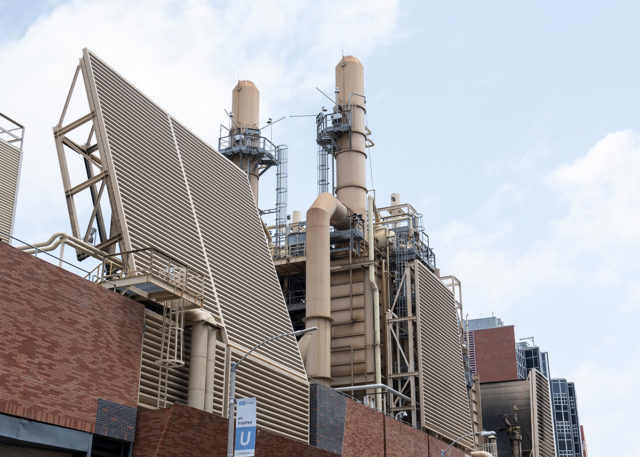This post was last updated May 16 at 7:43 p.m.
University of California community members are calling for an update to UC climate policies, citing missed targets, a lack of transparency and an unambitious approach.
Since 2003, the UC Office of the President has laid out 12 sustainability priorities along with individual policy goals and timelines for each of their campuses to meet by 2020 relating to energy, water, waste, transportation and other areas. However, Stett Holbrook, a UCOP spokesperson, said in an emailed statement that its sustainability targets and priorities are changing as new information regarding climate justice emerges.
Grassroots organizations, such as the UC Green New Deal Coalition, have been pushing for more transparency in the UC’s green policies and have been calling for change to their decarbonization goals.
The UC green goals: Have they been met?
The UC began its commitment to sustainability in 2003 and has since expanded the scope of its Sustainable Practice Policy to include areas such as climate protection, transportation and zero waste, according to the UCOP 2021 sustainability report.
The UC system achieved about 70% waste diversion – solid waste that is put toward food recovery and recycling instead of being sent to landfills – by its intended target in 2012, according to the UCOP 2021 sustainability report.
After the lower waste target was set in 2012, there were many changes to the recycling industry that led to updated policy targets, said Nurit Katz, UCLA’s chief sustainability officer, in an emailed statement. The goal has since been changed to better accommodate changes and new data regarding waste diversion, she added.
Katz said the new targets set a 25% waste-reduction goal per person from 2015-2016 levels by 2025 and a 50% reduction by 2030. The new policy additionally includes a 90% municipal solid waste diversion from landfills and a phase-out of single-use plastic items, she said.
UCLA also missed the University’s 2014 goal to reduce water consumption by 20%, achieving only a 13% decrease. Additionally, the 2021 UC sustainability report found that on most UC campuses, water usage did not decrease proportionally to the decreased numbers of students on campus because of COVID-19 closures.
However, Holbrook said approximately 30% of the University’s electricity is coming from its own power company, UC Clean Power, which supplies carbon-free electricity. Overall, he said around 55% of the UC’s electricity comes from renewable or carbon-free sources, adding that the UC achieved its goal of lowering greenhouse gas emissions to their 1990 levels.
On April 22, UCLA updated its comprehensive sustainability plan to merge academic and community engagement. The new goals include UCLA phasing out single-use plastic by 2023, achieving 100% clean electricity and a carbon neutral campus transportation system by 2025, reducing single-occupancy commuting vehicles, and increasing sustainable food practices.
The difference between carbon neutrality and carbon zero
The UC announced its Carbon Neutrality Initiative in 2013, pledging to emit net zero greenhouse gases from its buildings and vehicle fleets by 2025, according to UCOP.
However, carbon neutrality, one of the main goals of the UC, is flawed, said Taylor McKie, a doctoral candidate in oceanography at UC San Diego.
The UC’s current 2025 carbon neutrality goal does not require campuses to cut their emissions, said Adam Aron, a psychology professor at UCSD and a member of the UC Green New Deal Coalition. Rather, the UC will buy carbon offsets or pay other companies to cut their emissions to compensate for the University’s carbon emissions, he said.
UCLA has bought hundreds of thousands of tonnes worth of offsets from landfills located in other states such as Oklahoma and Montana, according to data published by Electrify UC, an organization of UC community members working to combat climate change.
UCLA pays these landfills to burn methane, which converts to carbon dioxide, said Alexander Andriatis, an oceanography doctoral student at UCSD. He added that this allows UCLA and other UCs to write off emissions from their campuses’ cogeneration plants, which produce energy for the campuses, without actually significantly reducing them.
“Instead of … actually decreasing our own carbon emissions, (the UC is) paying other people to theoretically decrease their emissions,” said Megan Phelps, founder of the Climate Reality Project Campus Corps at UC Davis. “Those reductions in carbon emissions might have happened otherwise, even without the use of purchasing the offsets. ”
Thomas Murphy, a professor of physics at UCSD, said while carbon neutrality might look good on paper, the UC should try to limit the amount of fossil fuels it uses rather than relying on offsets.
Aron also said the UC faces challenges in addressing other practices affecting its carbon neutrality efforts. For example, he said, while increasing the efficiency of technology by cutting the amount of energy used is a beneficial improvement, the progress it creates is erased by campus expansions as they increase the overall energy used.
According to Electricity UC, another aspect of the UC carbon neutrality goal is paying other sites to change their fracked methane infrastructure to biomethane – without changing UC infrastructure itself. Aron added that this method essentially functions as an offset and is not a plan to cut emissions.
Another aspect of carbon neutrality is using renewable energy from the energy grid, Aron said. For example, around 20% of UCSD’s electricity comes from the grid. However, it is still only a small proportion of electricity, he said.
Some campuses may have an easier time transitioning to renewable energy, Andriatis said. For example, UC Davis’ rural location allows it to build solar arrays right next to campus that generate about 15% of the campus’s electricity, Andriatis said. However, for schools like UCLA or UCSD, renewable power sources would have to be built farther from campus and then be connected to the energy grid, which would require additional infrastructure to deliver and store energy, he said.
UC Green New Deal and the push for transparency
Aron said as a result of local grassroots efforts, there has been a shift at UC Berkeley, UC Davis and UCSD toward actual electrification planning. UC Berkeley made electrification plans that optimize electricity use on campus and move infrastructure away from being fossil fuel-based, he said, adding that the school is now asking the state for funding to stop using fossil fuels. He said UC Davis has started spending money for the shift, and UCSD has allocated money for the plans.
Andriatis said the UC should also be more transparent regarding its carbon emissions, offsets and future plans for electrification.
The UC is not actively updating the community on whether it has reached its sustainability goals, Phelps said, adding that it is difficult to find data about campus emissions or where carbon offsets are going.
The University does publicly publish annual sustainability reports in addition to the UC Board of Regents discussing updates on sustainable practice in its meetings.
Climate activists from UCSD’s Green New Deal Coalition – an organization that focuses on divestment from fossil fuels, decarbonization, climate education and building a UC-wide coalition – started a website to publish data on the UC’s carbon emissions they obtained through a public records request.
Another advocacy effort is the documentary “Coming Clean: A Demand for a Fossil Free UC,” which draws attention to the UC’s lack of sufficient climate action, highlighting that the UC is burning one million tons of fracked methane per year, said Andre Salehian, a UCSD alumnus and member of the UCSD Green New Deal.
Salehian said he created the film in 2020 with Carolina Montejo, a graduate student in fine arts student at UCSD, with the hopes of educating people and encouraging them to join the effort to decarbonize the UC.
Divestment from fossil fuels
Aron said the UC has an operating budget of around $30 billion to $40 billion a year being managed by Bank of America, Wells Fargo and Union Bank. These three banks finance fossil fuel extraction, which is damaging for the environment, he said, adding that some of the UC’s money directly finances fossil fuel extractions.
According to a letter from the University Committee on Faculty Welfare, these three banks have the worst records and policies in addressing climate change. The letter added that since the Paris Agreement, all three banks have lent half a trillion dollars to fossil fuel companies and have failed to adopt responsible criteria for financing the extraction of coal, tars sands and other carbon deposits.
Divestment from banks that invest in fossil fuels is a slow process for the UC because of its bureaucratic system, McKie said.
The solution to climate change is not simply a technical fix of converting solar and wind to electricity but also requires addressing the fundamental problem of economic systems, Murphy said.
Individual campuses can switch to smaller banks that do not invest in fossil fuels, but administrators are not informed about this ability because of miscommunication within the system, McKie said.
It would cost UCSD about $1 billion to eliminate the use of fossil fuels, Murphy said. Though the university is affluent, the enormous financial cost of decarbonization scares the administration away, he added. Fossil fuels are so cheap and easy to use that it’s hard to transition away from them, he said.
California’s budget surplus and electrification
The UCOP has requested a $1.6 billion capital outlay from Gov. Gavin Newsom to renovate buildings, update infrastructure, increase energy efficiency and conduct decarbonization studies across the UC system, said David Romps, a professor of earth and planetary science at UC Berkeley, in an emailed statement.
Romps said $365 million of the requested funds would be dedicated to constructing UC Berkeley’s clean energy system. The campus has already spent $1.75 million to prepare blueprints for the clean energy system, he added.
The full cost of decarbonization at UC Berkeley would be $700 million, according to a report from the UC Berkeley Office of Sustainability and Carbon Solutions.
The state legislature plans to make a decision in mid-May regarding the budget request, Romps said.
Since Berkeley’s methane gas plant is at the end of its life, these funds would provide the campus with a critical opportunity to electrify its energy system, Romps said.
UCLA has requested more than $145 million, which it says it will allocate to deferred maintenance energy accounting to the budget outlay, Romps said. He added it is possible that UCLA might be pursuing a large investment in its fossil fuel infrastructure.
The broader impact of green goals
The UC sustainability goals are doing too little, too late, Phelps said.
The carbon neutrality goal fails to take climate justice into account, she said. By continuing to use fossil fuels, the UC is exposing its students to the harmful effects of pollution, such as asthma and other health problems, she added.
Most of the UC’s fracked methane comes from the Central Valley, exposing those living near fracking facilities to toxic gas and chemical waste, according to Electrify UC. People living near these facilities have disproportionate levels of asthma, cancers and other health problems, according to Electrify UC.
Despite having some of the best climate scientists in the world, the UC’s goals are not progressive enough and do not reflect the urgency of the climate crisis, Phelps said.
“(It’s) one thing to fall short of your goal,” Phelps said. “It’s another thing to fall short of goals that were not even ambitious enough to begin with.”
Correction: The original version of this article misquoted Alexander Andriatis as saying UC Davis’ solar rays generate about 50% of the campus’s electricity. In fact, the solar rays generate about 15% of the campus’s electricity.



Comments are closed.